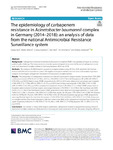2021-03-01Zeitschriftenartikel
The epidemiology of carbapenem resistance in Acinetobacter baumannii complex in Germany (2014–2018): an analysis of data from the national Antimicrobial Resistance Surveillance system
Said, Dunja
Willrich, Niklas
Ayobami, Olaniyi
Noll, Ines
Eckmanns, Tim
Markwart, Robby
Background
Carbapenem-resistant Acinetobacter baumannii complex (CRABC) has globally emerged as a serious public health challenge. This study aimed to describe epidemiological trends and risk factors of carbapenem resistance in A. baumannii complex isolates in Germany between 2014 and 2018.
Methods
We analysed 43,948 clinical A. baumannii complex isolates using 2014 to 2018 data from the German Antimicrobial Resistance Surveillance system. We applied descriptive statistics and uni- and multivariable regression analyses to investigate carbapenem resistance in A. baumannii complex isolates.
Results
The proportion of carbapenem resistance in clinical A. baumannii complex isolates declined from 7.6% (95% confidence interval [95% CI] 4.4–12.7%) in 2014 to 3.5% (95% CI 2.5–4.7%) in 2018 (adjusted OR [aOR] 0.85 [95% CI 0.79–0.93, p ≤ 0.001]). Higher mean CRABC proportions for 2014 to 2018 were observed in secondary care hospitals (4.9% [95% CI 3.2–7.5%], aOR 3.6 [95% CI 2.4–5.3, p ≤ 0.001]) and tertiary care hospitals (5.9% [95% CI 3.0–11.2%], aOR 5.4 [95% CI 2.9–10.0, p ≤ 0.001) compared to outpatient clinics (1.3% [95% CI 1.1–1.6%]). CRABC proportions in hospitals varied between German regions and ranged between 2.4% (95% CI 1.6–3.5%) in the Southeast and 8.8% (95% CI 4.2–17.3%) in the Northwest. Lower CRABC proportions were observed in younger patients (< 1 year: 0.6% [95% CI 0.2–1.3%]; 1–19 years: 1.3% [95% CI 0.7–2.5%]) than adults (20–39 years: 7.7% [95% CI 4.4–13.0%]; 40–59 years: 6.2% [4.2–8.9%]; 60–79 years: 5.8% [95% CI 4.0–8.3%]). In the 20–39 year old patient age group, CRABC proportions were significantly higher for men than for women (14.6% [95% CI 8.6–23.6%] vs. 2.5% [95% CI 1.3–4.5%]). A. baumannii complex isolates from lower respiratory infections were more likely to be carbapenem-resistant than isolates from upper respiratory infections (11.4% [95% CI 7.9–16.2%] vs. 4.0% [95% CI 2.7–6.0%]; adjusted OR: 1.5 [95% CI 1.2–1.9, p ≤ 0.001]).
Conclusions
In contrast to many other regions worldwide, carbapenem resistance proportions among clinical A. baumannii complex isolates are relatively low in Germany and have declined in the last few years. Ongoing efforts in antibiotic stewardship and infection prevention and control are needed to prevent the spread of carbapenem-resistant A. baumannii complex in Germany.
Dateien zu dieser Publikation

